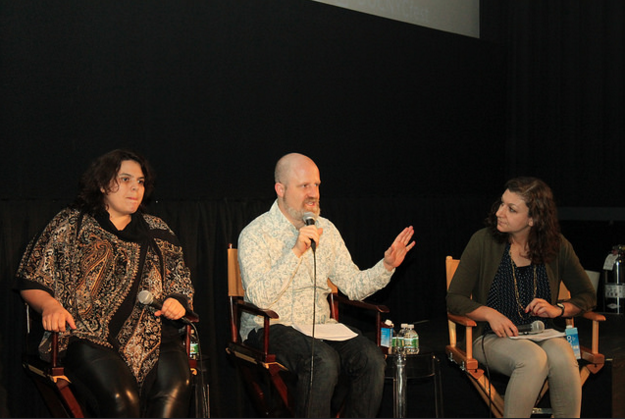By providing your information, you agree to our Terms of Use and our Privacy Policy. We use vendors that may also process your information to help provide our services. This site is protected by reCAPTCHA Enterprise and the Google Privacy Policy and Terms of Service apply.
Attention, Documentary Filmmakers: Industry Experts Give 5 Tips on How to Craft the Perfect Pitch

Aubrey Page

 Though it’s a reality many filmmakers might prefer not to face, making films (and especially documentaries) in the independent field often means a certain amount of pitching. In order to get your film realized, the realities of tipping your hat and accumulating financial partners for each stage of production is integral to a successful project. But the art of pitching is filled with pitfalls, with small tweaks often leading to the difference between an ambivalent “no” and an enthusiastic “yes.”
Though it’s a reality many filmmakers might prefer not to face, making films (and especially documentaries) in the independent field often means a certain amount of pitching. In order to get your film realized, the realities of tipping your hat and accumulating financial partners for each stage of production is integral to a successful project. But the art of pitching is filled with pitfalls, with small tweaks often leading to the difference between an ambivalent “no” and an enthusiastic “yes.”
READ MORE: What the Behind-the-Scenes Drama of a Documentary Pitch is Really Like
At this year’s DOC NYC, Sandi DuBowski of Good Pitch, Judith Helfand of Chicken & Egg Pictures and Reva Goldberg of Cinereach sat down with five potential pitchers to give expert tips on how to make your pitch irresistible to industry executives. Read their five essential tips below.
1. Pitch with Power
“I really think that pitching is a change in philosophy, everyone should pitch with power,” explained Sandy DuBowski. “We’re not filmmakers with begging bowls, going to the gatekeepers and hoping that they will open the gates so that we can come in. I really feel that we are partnering. I never had a distributor, I had a partner in distribution, which was New Yorker Films. So I really feel like we are adding incredible value/story. We are the reasons the people on those pitch tables have jobs. Be strong in your artistry and your story and realize that we walk proudly into our pitches.”
2. Know Who You Are
“It’s about finding your groove around what kind of pitcher you are,” DuBowski explained. “But it’s also about paying attention to the smaller details. It’s helpful to use notecards as opposed to something like a clipboard. They’re easier to flip and they also open your body a little more. Holding something small like a clipboard reduces the connection between us and you.”
Developing that connection is largely dependent on your ability to convey who exactly you are. “Your point of view and your very unique place that you have in relationship to your story that makes you who you are and not Barbara Walters is absolutely critical,” explained Judith Helfand. “It’s good to nest everything in the personal and in the eye. So instead of saying, ‘This is what we all want’ or ‘This is what one would want,’ it should be like, ‘This is what I look for, this is what I found.'”
3. Find a Partner, Not a Benefactor
“Sometimes we forget in the nerves and pressure that it’s really just a conversation between people,” Reva Goldberg explained. “I don’t think you should treat a pitch like something that you have to put on as this sort of sales-like approach; the more you are yourself and the more your own authentic passion is conveyed, the more people listening to your pitch will want to become a part of it and become part of your team. And ultimately, what you’re looking for is a relationship, not just this one shot deal where you say the magic words and the funding comes pouring in. What they’re looking at for you is becoming a partner on the project and making it happen.”
4. Don’t Pitch in a Vacuum
“Any time that you can situate your film in a context of other films, and make the distinction between it and others in the field, it can be so useful,” offered DuBowksi. Outside sources aren’t the only thing that can help bolster a pitch. In fact, a trailer, which is a commonly used pitching tool, can be immensely helpful, provided it’s employed the right way. “The trailer is the baton between you and your story,” Goldberg said. “You don’t have to start with it, you don’t have to put it in the middle, you don’t have to end with it, you just have to put it wherever it is in relationship to your story. You don’t want to say what your trailer says, you want it to be like a baton toss.”
5. Put Your Best Story Forward
It can be difficult to know at what point in your pitch you should couch your personal achievements and monetary goals, but one thing that everyone agreed on was where to position your story. “Start with story,” Goldberg said. “Story, story story. I’d never start a pitch saying what I do. Drop all of that and start with your story.”
Helfand held a similar position. “Start with your story and grab everyone. When everyone’s heart is in their mouth, that’s when to ask for your money.” Before concluding, Helfand added, “And never apologize. No matter what stage of development you are in, never apologize.”
By providing your information, you agree to our Terms of Use and our Privacy Policy. We use vendors that may also process your information to help provide our services. This site is protected by reCAPTCHA Enterprise and the Google Privacy Policy and Terms of Service apply.

















